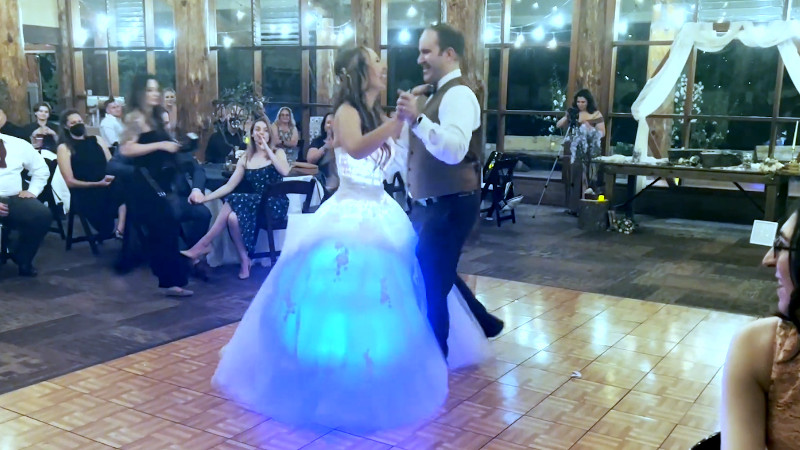The first dance of a newly married couple at the wedding reception is both a sentimental and memorable event, so why not make it even more so with something a bit special? Hackaday alumnus [Brett Haddoak] and his wife [Rachelle] certainly achieved that, with 1200 addressable LEDs turning her wedding dress into a real-life reproduction of Princess Aurora’s color changing dress from Disney’s Sleeping Beauty.
Tradition dictates that a groom must not see the dress before the Big Day, thus the LEDs were fixed to a petticoat and bustier that go underneath. The design would need so many LEDs that it crossed the limit that an Arduino can address, thus there were two Arduinos to control the whole. Electronics and batteries were worn in a pair of polo shorts, and after some nail-biting moments involving flaky connections, the whole thing came to life. The result can be seen in the video below the break, and certainly comes with a significant wow factor!
We would like to wish the happy couple all the best for the future, and we hope that this won’t be their last such electronic collaboration. If you’re hungry for more, it’s not the first light-up wedding outfit we’ve brought you.















+1
This is what we need every day.
I did something similar for the dress I wore for my stepdown as Miss Majestic Hearts in 2016, though on a smaller scale. I sewed half a dozen NeoPixel strips and an Arduino (an Adafruit Flora, actually) into the underlayer of a fancy dress (covered by a sheer overlayer), with a pushbutton control strapped around my wrist to control the light program as I lipsynced and danced. It was based on a design I’d seen elsewhere, but I modified it to allow a certain amount of manual control, rather than random light effects.
1200 Neopixels is not more than one Arduino can address. You need 3 bytes/LED, and an Arduino Mega can handle that.
The real challenge is the power. This will exceed 100 W if you light everything up, and you have to pay attention to how you run the wires.
Also probably have to prepare the bride with sauna training sessions and nomex knickers.
Read the article (why do I bother) – they were using Nanos, and hit memory constraints. So the description is accurate.
Sure, you could use a different Arduino. So what? Two nanos is still much more convenient than a single Mega.
No need for a Mega. An Tiny87 can address any number of LEDs of they’re in suitable groups (like in that dress).
That was a constraint I found in making my dress, too. Since I was running off 3 AAA batteries, I didn’t have enough power to light up more than a few LEDs per strip at once. I ran my “animations” at something like 25-30 “frames” per second, though, and that allowed me to create some really cool effects using just a small number of LEDs.
Just do it in post production :-)
Excellent! Hopefully the electronics were easily removable, seems like that would be uncomfortable and hot even when not using electricity.
Reminds me of a Disneyland electric parade.
This is so beautiful. Well done.
Now if someone could do the Katnis fire dress…
Ask, and ye shall receive:
https://blog.arduino.cc/2021/12/16/this-maker-designed-an-interactive-led-lit-dress-inspired-by-katniss-everdeens/
Interesting and a +1 for the attempt but doesn’t even come close. Very crude and has a long way to go. Sorry but I will wait for a better fire dress interpretation.
Most camerae don’t get the depth of color but those diehard flashers really miss out.
If you make the LEDs scroll paid-for text messages… does that make this garment an Ad-dress?
Heck of an ad-blocker needed then.
Dull effects, for *just* 1200 LEDs ….
Yep. Where’s the rainbows and the spins around the vertical axis? Maybe a spinning map of the moon? :-)
If the dress is sheer enough, you could see a moon!
That’s for the second part of the night, duh!